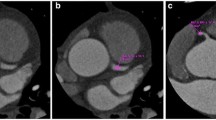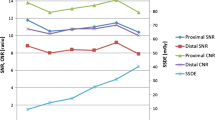Abstract
To investigate the image quality and the minimum required radiation dose for automatic tube potential selection (ATPS) in dual-source computed tomography (DSCT) coronary computed tomography angiography (CCTA). Three hundred twenty-five consecutive patients (153 men and 172 women) undergoing CCTA were assigned to either the ATPS group (n = 172) or the control group (n = 153); the control group underwent imaging at a constant current of 120 kV. All patients were scanned in either prospectively ECG-triggered high-pitch helical mode or sequential mode. The subjective image quality score, attenuation, image noise, signal-to-noise ratio (SNR), contrast-to-noise ratio (CNR), volume CT dose index (CTDIvol), and effective dose (ED) were compared between the two groups with the Student t test or Mann–Whitney U test. The subjective image quality score was not significantly different between the two groups. Imaging noise and attenuation were both significantly higher in the ATPS group than in the control group (imaging noise: 25.6 ± 7.6 versus 15.8 ± 4.0 HU, P < 0.001; attenuation: 559.6 ± 142.0 versus 412.5 ± 64.3 HU, P < 0.001). SNR and CNR were significantly lower in the ATPS group than in the control group (SNR: 23.21 ± 7.40 versus 27.71 ± 8.25, P < 0.001; CNR: 27.81 ± 8.44 versus 33.94 ± 9.69, P < 0.001). ED was significantly lower in the ATPS group than in the control group (ED: 1.25 ± 1.24 versus 2.19 ± 1.77 mSv, P < 0.001). For both groups, ED was significantly lower in the high-pitch mode than in the sequential mode. The use of ATPS for CCTA significantly reduced the radiation dose while maintaining image quality.


Similar content being viewed by others
References
Pugliese F, Mollet NR, Hunink MG, Cademartiri F, Nieman K, van Domburg RT, Meijboom WB, Van Mieghem C, Weustink AC, Dijkshoorn ML, de Feyter PJ, Krestin GP (2008) Diagnostic performance of coronary CT angiography by using different generations of multisection scanners: single-center experience. Radiology 246(2):384–393. doi:10.1148/radiol.2462070113
Schuijf JD, Pundziute G, Jukema JW, Lamb HJ, van der Hoeven BL, de Roos A, van der Wall EE, Bax JJ (2006) Diagnostic accuracy of 64-slice multislice computed tomography in the noninvasive evaluation of significant coronary artery disease. Am J Cardiol 98(2):145–148. doi:10.1016/j.amjcard.2006.01.092
Johnson TR, Nikolaou K, Busch S, Leber AW, Becker A, Wintersperger BJ, Rist C, Knez A, Reiser MF, Becker CR (2007) Diagnostic accuracy of dual-source computed tomography in the diagnosis of coronary artery disease. Invest Radiol 42(10):684–691. doi:10.1097/RLI.0b013e31806907d0
Einstein AJ, Henzlova MJ, Rajagopalan S (2007) Estimating risk of cancer associated with radiation exposure from 64-slice computed tomography coronary angiography. JAMA 298(3):317–323. doi:10.1001/jama.298.3.317
Sun Z, Choo GH, Ng KH (2012) Coronary CT angiography: current status and continuing challenges. Br J Radiol 85(1013):495–510. doi:10.1259/bjr/15296170
Gerber TC, Carr JJ, Arai AE, Dixon RL, Ferrari VA, Gomes AS, Heller GV, McCollough CH, McNitt-Gray MF, Mettler FA, Mieres JH, Morin RL, Yester MV (2009) Ionizing radiation in cardiac imaging: a science advisory from the American heart association committee on cardiac imaging of the council on clinical cardiology and committee on cardiovascular imaging and intervention of the council on cardiovascular radiology and intervention. Circulation 119(7):1056–1065. doi:10.1161/circulationaha.108.191650
McCollough CH, Bruesewitz MR, Kofler JM Jr (2006) CT dose reduction and dose management tools: overview of available options. Radiographics 26(2):503–512. doi:10.1148/rg.262055138
Wang D, Hu XH, Zhang SZ, Wu RZ, Xie SS, Chen B, Zhang QW (2012) Image quality and dose performance of 80 kV low dose scan protocol in high-pitch spiral coronary CT angiography: feasibility study. Int J Cardiovasc Imaging 28(2):415–423. doi:10.1007/s10554-011-9822-5
van der Wall EE, Jukema JW, Schuijf JD, Bax JJ (2011) 100 kV versus 120 kV: effective reduction in radiation dose? Int J Cardiovasc Imag 27(4):587–591. doi:10.1007/s10554-010-9693-1
Xu L, Zhang Z (2010) Coronary CT angiography with low radiation dose. Int J Cardiovasc Imaging 26(Suppl 1):17–25. doi:10.1007/s10554-009-9576-5
Hough DM, Fletcher JG, Grant KL, Fidler JL, Yu L, Geske JR, Carter RE, Raupach R, Schmidt B, Flohr T, McCollough CH (2012) Lowering kilovoltage to reduce radiation dose in contrast-enhanced abdominal CT: initial assessment of a prototype automated kilovoltage selection tool. AJR Am J Roentgenol 199(5):1070–1077. doi:10.2214/ajr.12.8637
Winklehner A, Goetti R, Baumueller S, Karlo C, Schmidt B, Raupach R, Flohr T, Frauenfelder T, Alkadhi H (2011) Automated attenuation-based tube potential selection for thoracoabdominal computed tomography angiography: improved dose effectiveness. Invest Radiol 46(12):767–773. doi:10.1097/RLI.0b013e3182266448
Austen WG, Edwards JE, Frye RL, Gensini GG, Gott VL, Griffith LS, McGoon DC, Murphy ML, Roe BB (1975) A reporting system on patients evaluated for coronary artery disease. Report of the Ad Hoc committee for grading of coronary artery disease, council on cardiovascular surgery, American heart association. Circulation 51(4 Suppl):5–40
Park YJ, Kim YJ, Lee JW, Kim HY, Hong YJ, Lee HJ, Hur J, Nam JE, Choi BW (2012) Automatic tube potential selection with tube current modulation (APSCM) in coronary CT angiography: comparison of image quality and radiation dose with conventional body mass index-based protocol. J Cardiovasc Comput Tomogr 6(3):184–190. doi:10.1016/j.jcct.2012.04.002
Halliburton SS, Abbara S, Chen MY, Gentry R, Mahesh M, Raff GL, Shaw LJ, Hausleiter J (2011) SCCT guidelines on radiation dose and dose-optimization strategies in cardiovascular CT. J Cardiovasc Comput Tomogr 5(4):198–224. doi:10.1016/j.jcct.2011.06.001
Hausleiter J, Martinoff S, Hadamitzky M, Martuscelli E, Pschierer I, Feuchtner GM, Catalan-Sanz P, Czermak B, Meyer TS, Hein F, Bischoff B, Kuse M, Schomig A, Achenbach S (2010) Image quality and radiation exposure with a low tube voltage protocol for coronary CT angiography results of the protection II trial. JACC Cardiovasc Imaging 3(11):1113–1123. doi:10.1016/j.jcmg.2010.08.016
Blankstein R, Bolen MA, Pale R, Murphy MK, Shah AB, Bezerra HG, Sarwar A, Rogers IS, Hoffmann U, Abbara S, Cury RC, Brady TJ (2011) Use of 100 kV versus 120 kV in cardiac dual source computed tomography: effect on radiation dose and image quality. Int J Cardiovasc Imaging 27(4):579–586. doi:10.1007/s10554-010-9683-3
Ripsweden J, Brismar TB, Holm J, Melinder A, Mir-Akbari H, Nilsson T, Nyman U, Rasmussen E, Ruck A, Cederlund K (2010) Impact on image quality and radiation exposure in coronary CT angiography: 100 kVp versus 120 kVp. Acta Radiol 51(8):903–909. doi:10.3109/02841851.2010.504740
Leschka S, Stolzmann P, Schmid FT, Scheffel H, Stinn B, Marincek B, Alkadhi H, Wildermuth S (2008) Low kilovoltage cardiac dual-source CT: attenuation, noise, and radiation dose. Eur Radiol 18(9):1809–1817. doi:10.1007/s00330-008-0966-1
Yu L, Bruesewitz MR, Thomas KB, Fletcher JG, Kofler JM, McCollough CH (2011) Optimal tube potential for radiation dose reduction in pediatric CT: principles, clinical implementations, and pitfalls. Radiographics 31(3):835–848. doi:10.1148/rg.313105079
Oda S, Utsunomiya D, Funama Y, Awai K, Katahira K, Nakaura T, Yanaga Y, Namimoto T, Yamashita Y (2011) A low tube voltage technique reduces the radiation dose at retrospective ECG-gated cardiac computed tomography for anatomical and functional analyses. Acad Radiol 18(8):991–999. doi:10.1016/j.acra.2011.03.007
Suh YJ, Kim YJ, Hong SR et al (2013) Combined use of automatic tube potential selection with tube current modulation and iterative reconstruction technique in coronary CT angiography. Radiology 269(3):722–729
Conflict of interest
None
Author information
Authors and Affiliations
Corresponding author
Rights and permissions
About this article
Cite this article
Wang, Y., Wang, X., Zhang, Y. et al. Image quality and required radiation dose for coronary computed tomography angiography using an automatic tube potential selection technique. Int J Cardiovasc Imaging 30 (Suppl 2), 89–94 (2014). https://doi.org/10.1007/s10554-014-0526-5
Received:
Accepted:
Published:
Issue Date:
DOI: https://doi.org/10.1007/s10554-014-0526-5




